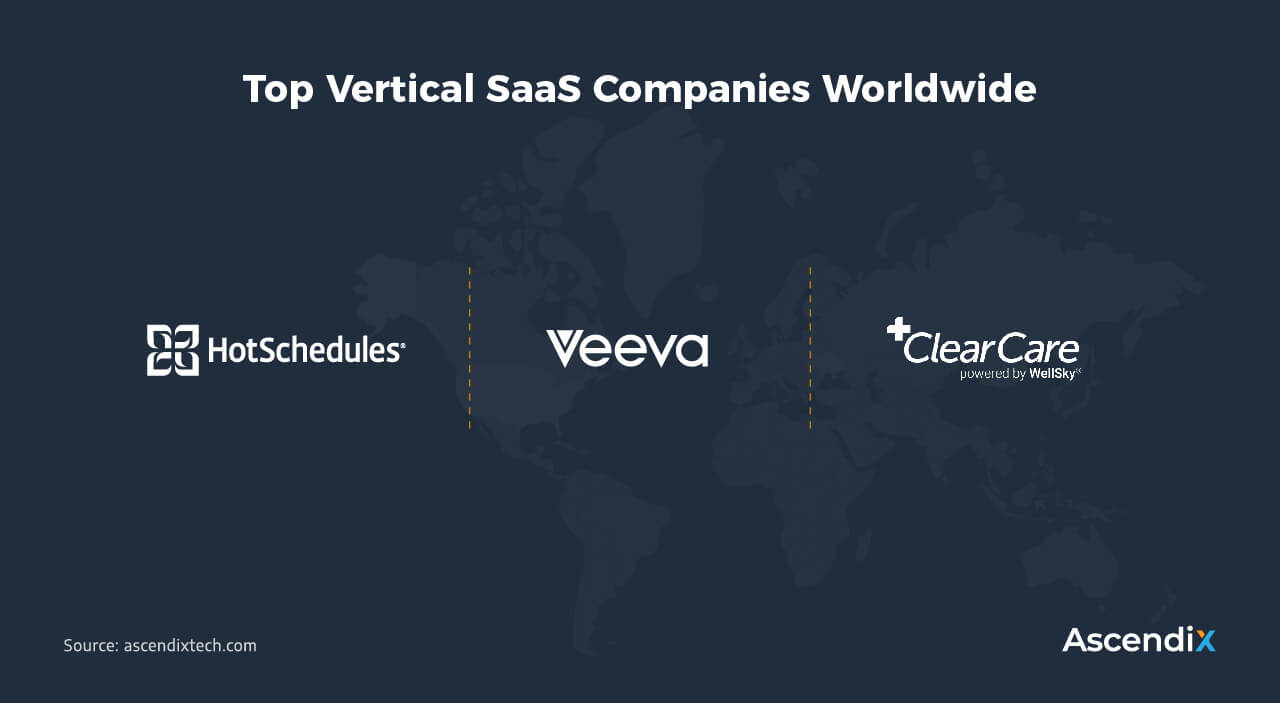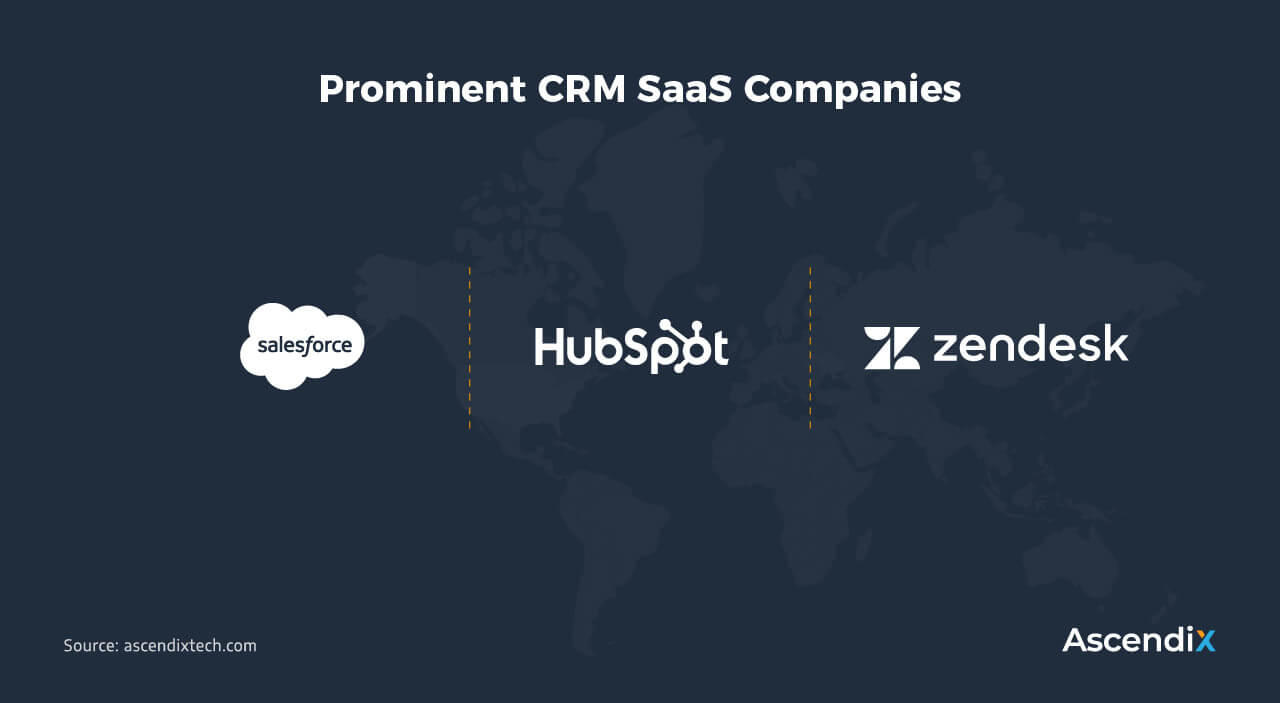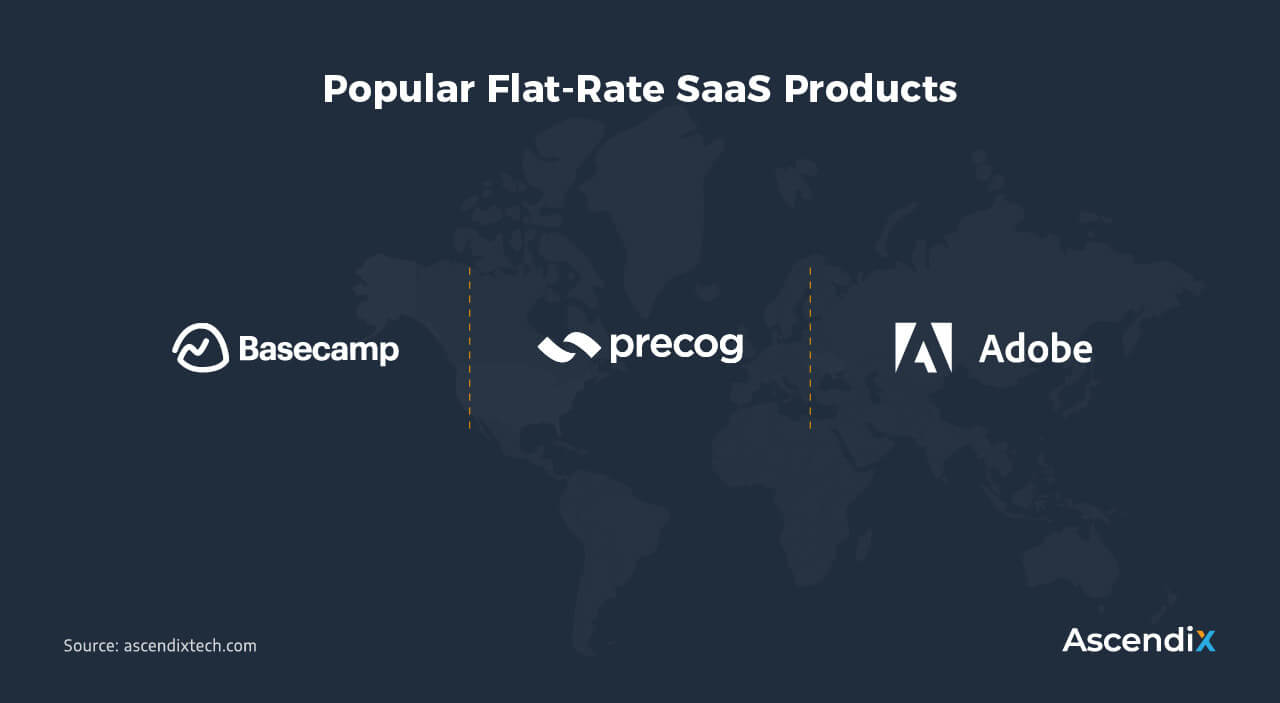Build Your SaaS Product with Us
See how Ascendix Tech can boost your business using advanced custom software development solutions.
According to Statista, the total size of the worldwide SaaS market will hit $309B by 2023.
This means more and more SaaS companies emerge daily.
No installation, configuration, updates, and compatibility issues make SaaS products a beneficial choice for both users and entrepreneurs.
In this guide, we’ll share 5 working steps to building a SaaS product loved by your end-users yet profitable for you.
We’ll feature the following details:
SaaS refers to a cloud computing model which provides users with access to the application’s functionality by paying monthly/yearly subscription fees. A web browser and an Internet connection are the only requirements to start using a SaaS product.
One of the key win-win strategies of SaaS technology for both users and you are the remote cloud hosting of products by dedicated servers.
This means that you can save funds on costly hardware maintenance and support.
In turn, users can avoid installation, configuration, and update challenges they experience with mobile or desktop applications.
Surely, you have heard or personally used multiple examples of software as a service software like Google Drive.
It stands for a cloud-based office-suite platform that allows you to store files on their servers, synchronize files across devices, and share files.
Among other popular and successful SaaS applications are as follows:
The technology market is constantly growing, and users are becoming more and more demanding of software quality and flexibility.
For these reasons, SaaS applications currently cover most of the business spheres that may benefit from the Software-as-a-Service technology.
Now let’s take a look at the key 6 types of SaaS products and 18 top examples of software as a service solutions:
This software type allows businesses to create a cloud-based e-Commerce product with a wide range of features like inventory management, payment integration, easy-to-use checkout process.
Among the top SaaS e-Commerce products are BigCommerce, Shopify, and Volusion.

E-Commerce | Types of SaaS Products
Vertical SaaS products are cloud-based software solutions that cater to a specific market niche.
Simply put, these SaaS applications aim at meeting the distinct needs of users within a single industry.
The most famous vertical SaaS companies are Veeva (life sciences research), HotSchedules (restaurant management), and ClearCare (home care management).

Vertical | Types of SaaS Products
This type of software helps companies and teams improve communication, increase productivity, and boost a company’s culture.
The most widespread SaaS collaboration software are Slack, Zoom (it has a cloud-based web version), and Trello.

Collaboration | Types of SaaS Products
Cloud-based customer relationship management SaaS software allows businesses to track lead flow, contact clients, automate and boost sales whenever and wherever they are.
For sure, the most famous CRM SaaS solutions are Salesforce, HubSpot, and ZenDesk.

CRM | Types of SaaS Products
Fast-growing cloud-based enterprise resource planning software provides companies with advanced features to manage their business process in real-time.
Popular ERP SaaS software includes Odoo, Oracle ERP Cloud, and Scoro.

ERP | Types of SaaS Products
Cloud-based billing software provides users with a payment gateway, merchant account, and subscription management platform that can also include advanced analytics features.
Best SaaS billing software includes Stripe, Braintree, and Recurly.
Let’s discuss the key advantages of Software-as-a-Service that stimulate entrepreneurs and startups to build a new SaaS product and roll it to the market.
We believe these benefits will bring you closers to realizing the key steps to building a SaaS product.
The usage of cloud-based environments does not implicate your business to purchase a license as in the case of packaged software.
What’s more, there are+ no hardware maintenance costs that are required when dealing with on-premises software.
So, you pay exactly for what you use.
The cloud environment always provides end-users with the most up-to-date version of your custom software.
It means they do not need to update and install the latest version as it’s done in the background.
Compared with multiple other business models, SaaS technology allows your business to generate recurring revenue and always keep track of your monthly/yearly earnings.
It becomes possible with a subscription model which means that your clients pay a specific fee each month or year while other business models require constant user acquisition as most users pay a one-time fee for the software.
Once you attract a solid base of customers to your SaaS app that provides you with recurring revenue, you can focus on expanding and growing your business without any worries about your bottom line.
The subscription model allows you to up- or downscale users in real-time.
All you need is to upgrade or downgrade a subscription plan based on users’ needs.
In case you have several options only, it also doesn’t require much engagement from your side to create a flexible plan that fits the current scalability of users.
This way, on-the-go flexibility is among the key advantages of SaaS software that make your life easier.
See how Ascendix Tech can boost your business using advanced custom software development solutions.
First, conduct market research to find clear-cut answers to the following questions:
Once you get the answers to these requests, you will be clear on your high-level target audience, competitors, and market demand.
One of the key aspects here is to realize why users will choose or intend to pick your SaaS product. In order to verify your business idea at the start, you can greatly benefit from performing the following activities:
#1 Set up focus groups
This marketing approach means that you gather a certain number of users of your target audience that have similar geographical, social, demographic, and other parameters to interview them based on the same questions.
It’s one of the most time- and cost-consuming solutions that can provide you with a qualitative measurement of your project idea.
#2 Interview via social media
This approach is much easier and cost-effective compared to focus groups. You just need to select a group of 10-20 users with similar geo, social, and demographic characteristics to interview them by the same questionnaire.
We recommend you prepare a small bonus for the selected users like commenting, liking, or sharing their content to make it beneficial to spend time and help you with the questions.
What’s more, you can find LinkedIn, Facebook, Twitter groups, and Reddit subreddits with topics relevant to your product and submit a poll with a basic set of questions that will help you verify your SaaS product idea better.
When you decide to build a SaaS app from scratch, you should carefully prepare a detailed business plan. It is a clearly defined scope of operational and financial objectives that you want to reach.
A business plan is a detailed description of how to launch a SaaS business within your specific niche.
Simply put, you need to find solutions for all the steps to building a SaaS product.
These aspects in your business plan will help you realize how to build a SaaS product:
Monetization strategy (pricing model)
The SaaS technology offers multiple options to make a profit within your future product. Defining the monetization strategy is crucial at the beginning of SaaS software development.
It directly influences the way you will build a SaaS app functionality and help you realize how to sell SaaS technology products after release. So, here are the most wide-spread monetization strategies:
This monetization model means that your SaaS product provides limited features for free. If a user wants to access more functionality and opportunities, they can upgrade to a pro-paid plan.
Freemium is a great business model to start with as it allows your company to hook multiple users so that they sign up and give your SaaS app a try. The most important thing here is to provide enough free features that will allow your end-users to start getting benefits.
What’s more, carefully divide your SaaS product features into free and paid so that you get the highest conversion rate by suggesting pro-paid plans ONLY when users are greatly involved.
Among the top freemium SaaS companies are Zapier, Mailchimp, and Dropbox.
This model is probably the easiest for both your SaaS technology product company and users. It means that you provide a single set of features for a single price.
The most popular flat-rate pricing SaaS products are Basecamp, Consider, and Adobe Creative Cloud.

Popular Flat-Rate SaaS Products
This business model means that your charge fees will depend on the number of users that utilize your SaaS app. The more people use your software, the more favorable pricing they get.
This monetization strategy means that charge fees depend on the amount of storage space users need.
This model provides high flexibility as you can adapt to customers’ fluctuations and provide an individual amount of storage space if required.
Among the top SaaS per-storage model companies are Sync, Google Drive, and OneDrive.
Also known as usage-based pricing, the pay-as-you-go model means that the more customers use, the higher the charges and vice versa.
This strategy provides a huge user LTV (lifetime value) as you can always adopt pricing to their current revenue performance.
The leading pay-as-you-go SaaS apps are Chargify, ConvertKit, and SendGrid.
The features of your SaaS app are the key value you will provide to end-users. Depending on your niche and pricing strategy, the functionality can hugely vary but should include the core principles of a good SaaS product. They will help stand out from the competition in a beneficial way.
Let’s briefly discuss them:
High security
As you store customers’ data in the cloud, you should ensure high security against multiple vulnerabilities and hack attacks. It includes identity management, multi-factor authentication, access control, and others.
User-Friendliness
Try to make your SaaS application as easy-to-use as possible. Ease of use means that you offer customers simple navigation, high page load speed, and intuitive UI/UX design.
Try to avoid complex and large text blocks, many JS scripts and CSS styles that cut down your SaaS product performance, lots of motion design that also converts your app into a heavyweight appalling website with a low conversion rate.
Real-Time Support and Maintenance
Any software generates bugs and mistakes from time to time and SaaS products are no exception. We recommend you choose the SaaS programs providing ongoing support for customers so that you will be able to overcome any challenges your end-users will cope with.
Multi-Tenant Infrastructure
SaaS technology multi-tenancy is one of the key principles that drives cloud computing.
It stands for a system with multiple companies or tenants that share a single SaaS installation platform.
In order to find the key specific features for your niche SaaS application, analyze market competitors. We recommend you create a list of exact features that you personally want to implement and complement them by the ones from market rivals.
Focus on the must-have functionality that directly meets end-users’ needs and solves their challenges. It should become the core basis of your future minimum viable product (MVP).
Let’s discuss what is an MVP and why is it crucial for successful SaaS application development and launch.
Once gathered the requirements, you’re all set to develop a product.
But not all at once.
Building a SaaS MVP solution is what you need now.
Simply put, the minimum viable product (MVP) is a feature-limited version of your SaaS application. It still offers enough functionality to users so that they provide valuable feedback.
This is beneficial to verify your idea and value proposition without much time and fund spending.
So, here are the key objectives of building a SaaS MVP:
1. Collect feedback and verify your business idea
The core goal of an MVP approach is to collect early users’ feedback and realize what did they like/dislike, what features to add/remove/update.
2. Sound out the market situation
Once collected the feedback from your potential customers, you can conclude whether your value proposition is in demand among your target audience in the market.
Here is crucial to answering the following questions:
3. Test different approaches
MVP is about testing not only your SaaS application features but the business concept as well.
Try to collect users’ feedback on your product’s idea which may help you define the better way to grow your business.
In order to transform your business idea into a successfully launched SaaS product, you need to solve the technical side of your project – SaaS development.
Though, many entrepreneurs ask:
‘How to start a SaaS company if I lack technical resources?’
So, here are the answers.
1. Create your own in-house team
This option is probably the most time- and cost-consuming.
First, ideally, you need to find a CTO or technical partner.
This person will help you hire SaaS app developers in a fast and efficient way and further manage SaaS product development.
Such professionals can often cooperate as business partners or employees with fixed wages.
It means that you should be prepared for one of these partnership models beforehand.
Here you can ask:
‘Where can I find a CTO experienced in building SaaS products?’
The key acquisition channels to find a technical partner are LinkedIn networks, groups, and related Reddit subreddits where startups are looking for partners and vice versa.
Here are some of the most popular business-related subreddits:
A CTO or technical partner will be responsible for hiring app developers, conducting an interview, and further leading SaaS application development and team management processes.
So, you find the required technical specialists and start creating a SaaS product internally.
2. Hire freelance software engineers
This option is one of the riskiest as you cannot fully control the individuals responsible for building a SaaS product for your company.
Remote teams, time zone, and cultural differences, and other factors can greatly impact the final SaaS product quality.
But this approach can still work.
Perform daily meetings to update on the project development status and know exactly what is done/going to be done/collapsed.
What’s more, request frequent progress reports with screens or access to the staging environment.
They will help you personally check the project progress.
Speaking about acquisition channels, you can take advantage of such platforms as Upwork, Freelancer, Fiverr, Outsourcely, etc.
These websites collect thousands of professionals with internal ratings, portfolios, case studies, client reviews, etc.
3. Outsource software development to an IT agency
If you have enough budget, a SaaS application development company is a great choice.
First, a reliable IT agency has a solid background by default. It should have built multiple SaaS products thus knowing most hidden hazards.
This can greatly help you save much time and funds for SaaS application development.
Second, a software development consultancy can not only build your SaaS online application but also provide consulting services.
They can also help you save time and money as reliable engineers will honestly tell you what you actually need or don’t.
You can say that most companies tend to sell you as many features as possible.
And that’s partly true.
But this doesn’t mean there are no companies with your product and end-users in mind. Make your best to find such a partner.
Third, outsourcing software development allows you to avoid active involvement in the SaaS development process if you want to focus on building your marketing strategy or finding investors for your project.
We’re at your service with 10-year expertise. Just fill in the form and we’ll send an estimate
Try to implement the discussed 5 actual steps to building a SaaS product. All these stages require testing and adapting to your specific niche.
So, don’t just blindly dive into these steps directly, but try to get the essence of our words and implement them efficiently within creating a SaaS product.
We believe they will help you successfully launch and scale your solution.
If you’re looking for a SaaS application development company, Ascendix Tech is at your service.
We will be glad to facilitate your SaaS-based product development within any engagement model you prefer.
So, check our case studies or just drop us a line to discuss your business idea.
Daniil specializes in content marketing and has a deep knowledge of promoting the company's products and services through high-quality content. On the Ascendix blog, Daniil shares his tricks and tips on custom software development, provides technology trends and insights, and helps you get valuable content to make your business even more successful and profitable.
Get our fresh posts and news about Ascendix Tech right to your inbox.
Thanks for the post, nice information about the steps to buildinga SaaS product.